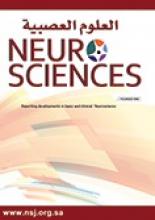Brief ReportBrief Communication
Open Access
The relationship between emotional intelligence and task-switching in temporal lobe epilepsy
Amara Gul and Imtiaz Hussain
Neurosciences Journal January 2016, 21 (1) 64-68; DOI: https://doi.org/10.17712/nsj.2016.1.20150321
Amara Gul
From the Department of Applied Psychology, The Islamia University of Bahawalpur, Bahawalpur, Pakistan
MPhil, PhDImtiaz Hussain
From the Department of Applied Psychology, The Islamia University of Bahawalpur, Bahawalpur, Pakistan
BS, MPhil
References
- ↵
- Long S
- ↵
- Harden CL
- ↵
- Helmstaedter C,
- Kurthen M,
- Lux S,
- Reuber M,
- Elger CE
- ↵
- Hermann BP,
- Seidenberg M,
- Dow C,
- Jones J,
- Rutecki P,
- Bhattacharya A,
- et al.
- ↵
- Tavakoli M,
- Barekatain M,
- Doust HT,
- Molavi H,
- Nouri RK,
- Moradi A,
- et al.
- ↵
- Höller Y,
- Trinka E
- ↵
- Walpole P,
- Isaac CL,
- Reynders HJ
- ↵
- Abdou H,
- Mohamed S,
- Nada MA,
- Helmy H
- ↵
- Sedda A,
- Rivolta D,
- Scarpa P,
- Burt M,
- Frigerio E,
- Zanardi G,
- et al.
- ↵
- Brosch T,
- Scherer KR,
- Grandjean D,
- Sander D
- ↵
- Roger RD,
- Monsel S
- ↵
- Mayr U,
- Kliegl R
- ↵
- Aron AR,
- Monsell S,
- Sahakian BJ,
- Robbins TW
- ↵
- Mayr U,
- Diedrichsen J,
- Ivry R,
- Keele SW
- ↵
- Saxe R
- ↵
- Shamay-Tsoory SG,
- Tomer R,
- Goldsher D,
- Berger BD,
- Aharon-Peretz J
- ↵
- Lough S,
- Kipps CM,
- Treise C,
- Watson P,
- Blair JR,
- Hodges JR
- ↵
- Schulte-Rüther M,
- Greimel E,
- Markowitsch HJ,
- Kamp-Becker I,
- Remschmidt H,
- Fink GR,
- et al.
- ↵
- American Psychiatric Association, editor
- ↵
- Wechsler D
- ↵
- Lovibond SH,
- Lovibond PF
- ↵
- Brown TA,
- Chorpita BF,
- Korotitsch W,
- Barlow DH
- ↵
- Bar-On R,
- Bar-On Emotional Quotient Inventory (EQ-i)
- ↵
- Schneider W,
- Eschman A,
- Zuccolotto A
- ↵
- Seghete KL,
- Herting MM,
- Nagel BJ
- ↵
- Kucukboyaci NE,
- Girard HM,
- Hagler DJ Jr.,
- Kuperman J,
- Tecoma ES,
- Iragui VJ,
- et al.
- ↵
- Leyden KM,
- Kucukboyaci NE,
- Puckett OK,
- Lee D,
- Loi RQ,
- Paul B,
- et al.
- ↵
- Stretton J,
- Thompson PJ
- ↵
- Hudson JM,
- Flowers KA,
- Walster KL
- ↵
- Hellwig S,
- Gutmann V,
- Trimble MR,
- van Elst LT
- ↵
- Riley JD,
- Franklin DL,
- Choi V,
- Kim RC,
- Binder DK,
- Cramer SC,
- et al.
In this issue
The relationship between emotional intelligence and task-switching in temporal lobe epilepsy
Amara Gul, Imtiaz Hussain
Neurosciences Journal Jan 2016, 21 (1) 64-68; DOI: 10.17712/nsj.2016.1.20150321
Jump to section
Related Articles
- No related articles found.
Cited By...
- No citing articles found.





